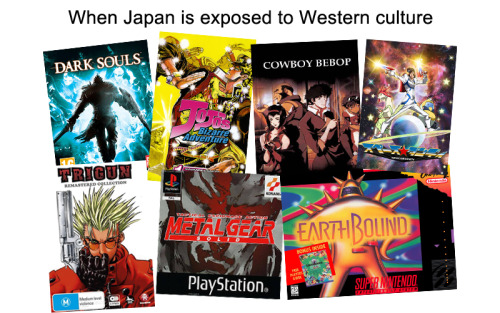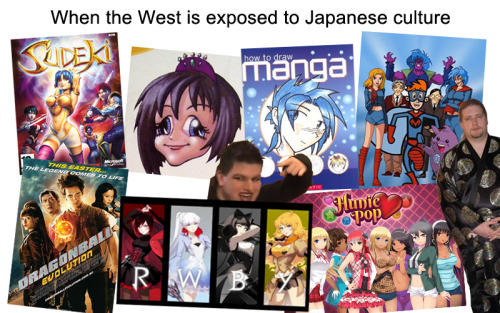lemonwicky:jaxblade:cari28ch3-me:mymahoushoujo:rip-roaring-muffin:everyonelovesrobots:where is the l
lemonwicky:jaxblade:cari28ch3-me:mymahoushoujo:rip-roaring-muffin:everyonelovesrobots:where is the lie though?It’s a lie of omission.You’re comparing highly polished mainstream examples of iconic Japanese media to low budget, indie, and amateur american works. If you wanted to be fair the second image should look more like this:The cultural exchange between American and Japanese art, particularly in animation, is hardly a one way streak.Here we have Panty and Stocking, which boasts an artistic style that draws heavily upon modern western animation with it’s hard outlines and comical proportions. Shows like Dexter’s Laboratory barrow dynamic posses, dramatic framing, and highly expressive faces form anime and manga. Early anime and manga developed it’s distinct big eyes and childlike features by taking cues from western animation of the 20′s and 30′sBetty Boop, in particular, was immensely popular in Japan. Her creators even made this short in appreciation of her Japanese fan-base.WAIT I CAN ADD TO THIS ALREADY OBSCENELY LONG POST.The entire Magical Girl genre is a big example of Western (primarily U.S.) and Japanese cultural exchange!BeWitched (which was inspired by the 1940′s American movie “I Married a Witch”) was incredibly popular with young girls! This prompted the creation of the first popular Magical Girl Sally the Witch.When the “Little Witch” Subgenre was big in the 70s the U.S. countered with animated Sabrina (from the Archie comics) which followed the same formula albeit with an older girl.The 80s we start seeing more “flash of light” henshins/transformations being utilized along with the rise of the “Magical Idol” sub-genre in Japan it gave birth to shows like Creamy Mami and Magical Emi, in the U.S. it made way for Jem and the Holograms and She-Re Princess of Power (not a magical idol but still uses “flash of light” transformations). Jem was even a collab with U.S. doing the writing and Japan doing the animation!The “Magical Warrior” sub-genre emerges in the 90s (even tho it has roots in the 70s with shows like Cutie Honey). This doesn’t catch on in America until the early 00′s with Atomic Betty (Canadian creation) and The Life and Times of Juniper Lee but we did see the start of it with the Canadian/Argentinian collab called Cyber Six. We also get W.I.T.C.H. and WINX Club in the early 00s from Italy which are both probably the most heavily influenced from Japan’s then current MG show structure.Today we have Steven Universe, Bee and Puppycat, Star vs. the Forces of Evil, Lolirock, The Miraculous Ladybug, and if it gets picked up Twelve Forever which are all great Western MG shows that are influenced by Japan!I could go on, I haven’t even scraped the ice berg on this! I have a whole hour panel I run on this subject called “Magical Girls from Around The World”The point is the Magical Girl genre- and tbh animation in general- has been Japan and America (with some other Western countries thrown in) talking back and forth since the 60s. I leave you with probably the most direct influence:can I add to this that Osamu Tezuka aka “the God of modern Manga”was inspired by Bambi into deciding to give big eyes to his drawings so that they would look more expresive. He also remained a big fan of a certain Jewish American animator until his death, oh yeah this guyWalt Disney himself was also intrested in Tezuka’s work, with Astroboy being one of his favorites. A similar case exists now between John Lasseter (Pixar and Disney fame) and Hayao Miyasaki (Studio Ghibli) who are big fans of each other’s work.Japan and America are less of a competition to those who work on it and more of an inspiration, it is very often the fans and not the creators who create rivalries between people that would be friends in real life.Originally posted by yourreactiongifsSWEET JESUS HALLELUJAH THIS SITE CAN PRODUCE SOME GOOD I LOVE POSTS LIKE THESE. -- source link
Tumblr Blog : hawfstuff.com

